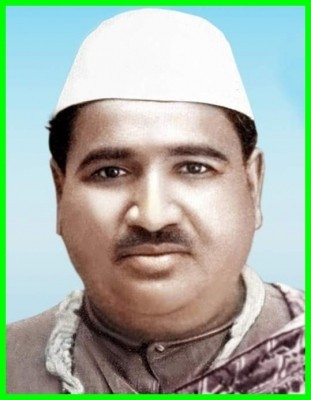
Mumbai, Akin to that tiny village in ancient Gaul which rattled the Romans in the fictional world of Asterix and Obelix, Satara's freedom hero, Nana Ramchandra Pisal, alias 'Kranti Simha Nana Patil', unnerved the mighty British Raj with his unique 'Prati Sarkar (Alternative Government) Movement' in the 1940s in Maharashtra.
It was a parallel regime by all counts which needled the British for several years - as it was launched soon after Mahatma Gandhi's historic 'Quit India' call in Bombay on August 8, 1942.
"Nana Patil and his band of followers took it to heart and 'clamped' down on the foreign rulers in Satara, in one of the most radical rebellions in the country... resulting in police firing at 5 places, killing 11 patriots," noted scholar from Kolhapur, Prof. (Dr.) Maya Pandit, the ex Pro Vice Chancellor of the prestigious EFL University, Hyderabad, told IANS.
Though the British brutally quelled the rebellion with support of local armies of feudal lords, thugs and criminals, it continued for around 3 years and represented the common Indian's tremendous craving for freedom and later Nana Patil re-ignited the fires in the masses' hearts, she said.
Nana Patil (August 3, 1900-December 6, 1976), initially worked with the Congress and post-Independence with the Peasants & Workers Party, was given a Communist Party of India (CPI) ticket and elected MP from his birthplace Satara (1957) and Beed (1967).
At the age of 19, he plunged into social service through Prarthana Samaj - founded in 1867 by Dr. Atmaram Pandurang of Mumbai (who also co-founded the Bombay Natural History Society in September 1883) and fought against superstitions and harmful traditions.
Later, Nana Patil joined the Satyashodhak Samaj - launched in September 1873, by the legendary reformer, Mahatma Jyotirao G. Phule - and fought to eradicate social evils like dowry, child marriages, and rigid caste system, and to encourage girls' education.
Founding the Hindustan Republican Association, he retreated underground for 3 years in 1929, and suffered at least 8 jail terms between 1932-1942, for his 'direct attacks' on the colonial rulers and sometime along the route, earned the nickname of 'Kranti Simha' (Revolutionary Lion) Nana Patil.
Prof. Pandit said the Prati Sarkar Movement was "rare" as it challenged the established and repressive power structures, aimed at creating a new society led by peasants and workers and sans exploitation in the name of class, caste, religion or gender.
"Nana Patil was inspired by the legendary Bhagat Singh, the struggles against the German fascist forces of Adolf Hitler in Europe, and concluded that to win against the British, he should identify and target its 'power centres' and raze them," she said.
Accordingly, he formed a disciplined band of youth called 'Toofan Sena' (Storm Army), that attacked police stations, locked up the cops, grabbed their weapons, pounced on British government treasury boxes sent in trains or buses for salaries of its staffers and used it to finance its own revolutionary activities, torched bus or railway stations, etc. all of which struck terror among the rulers.
The Toofan Sainiks swooped on cruel money-lenders - not unlike Kanhaiyalal's portrayal of the cut-throat Sukhi Lala in "Mother India" (1957) - looted their ill-gotten wealth, burnt loan documents of farmers and unilaterally declared them 'debt-free', on the lines of the All India Kisan Sabha's vision, said the current AIKS President Dr. Ashok Dhawale.
"Nana Patil's 'Prati Sarkar' was like a regime that 'functioned' - it took up public demands and forthwith implemented them, instilling huge confidence among the downtrodden villagers and farmers, and even shared the plundered booty with them," he said.
Prof. Pandit said Prati Sarkar Movement in Satara - then a huge region - addressed burning social subjects by targeting caste system, promoting inter-caste marriages and widow remarriages, prohibition, release of prisoners, encouraged art and culture, and organised 'Jalsas' (festivals) of dance and music to bring out the creative aspects among the people.
"It communicated with the masses in their own lingo, propagated the ideals of Karl Marx, V.I. Lenin, Mahatma Jyotirao Phule and Dr. B. R. Ambedkar... It had a profound impact and at the height of the British Rule, the Indian tricolour fluttered over all homes and village offices for months together," she said.
The duo explained how the Prati Sarkar Movement was not just a fly-by-night operation, but had a strong foundation guided by scientific thinking and mirroring peoples' sentiments.
It had all the organs of a new, workable state, a committed army expert in guerrilla warfare against the British, a treasury to finance various public upliftment programmes, an organising committee to oversee the implementation of these initiatives, a strong justice delivery system, a panel to communicate and spread genuine news among the masses, schools to train the cadres of which the most popular was the Toofan Sena, and other aspects of ideal governance.
Nana Patil continued the traditions in Independent India, helping the cause of farmers, joining the liberation movements of Maharashtra, Hyderabad and Goa, and became the AIKS President in 1955.
"The struggles against exploitation continue even today, like the recent (2020-2021) nationwide farmers movement, and Nana Patil's traditions stand out against the backdrop of the terribly regressive and increasingly fascistic state in India now," rued Dr. Dhawale.


.jpeg)

